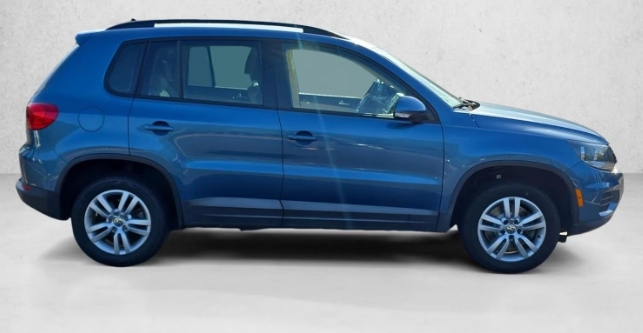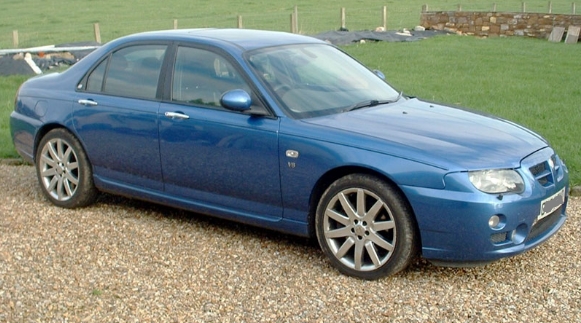The Volkswagen Tiguan: A Journey Through Evolution
The automotive landscape is a constantly shifting terrain, with manufacturers perpetually striving to meet the evolving demands of consumers. Among the most successful adaptations has been the rise of the compact SUV, a segment that has exploded in popularity over the past two decades. Volkswagen, a brand known for its engineering prowess and pragmatic approach, recognized this burgeoning trend and introduced a vehicle that would come to define its presence in this crucial market segment: the Tiguan. What began as a bold new venture has transformed into a globally successful model, consistently refined and re-engineered to remain at the forefront of its class. This article delves into the fascinating evolution of the Volkswagen Tiguan, tracing its journey from its inception to its current iteration, highlighting key production years, significant redesigns, and the diverse range of models and trim levels that have shaped its enduring appeal.
The Genesis: First Generation (2007-2016)
The story of the Tiguan officially begins at the Frankfurt Motor Show in 2007, where Volkswagen unveiled its highly anticipated compact SUV. While sharing its platform with the successful Golf hatchback, the Tiguan presented a more rugged and adventurous persona. It was designed to bridge the gap between a traditional family car and a more capable off-road vehicle, offering a blend of practicality, comfort, and a touch of premium feel that was characteristic of Volkswagen.
The first generation Tiguan was built on the venerable PQ35 platform, the same underpinnings as the Golf Mk5. This provided a solid foundation for a refined driving experience, far removed from the utilitarian nature of some of its competitors. Initially, the Tiguan was offered with a range of efficient petrol and diesel engines, typically paired with front-wheel drive or Volkswagen’s renowned 4Motion all-wheel-drive system.
Key Model Years and Trim Levels (First Generation):
- 2007: Introduction of the Tiguan, initially in select markets.
- 2008: Wider global rollout and the establishment of core trim levels.
The initial trim strategies varied by region, but common themes emerged across Volkswagen’s markets:
- S (or equivalent): The base model, offering essential features, often with manual transmission as standard and a focus on value.
- SE (or equivalent): A mid-range option, adding comfort and convenience features such as alloy wheels, enhanced infotainment systems, and more sophisticated interior materials.
- SEL (or equivalent): The higher-end trim, typically featuring premium amenities like leather upholstery, advanced climate control, larger alloy wheels, and more potent engine options.
Engine options during this period were diverse and evolved over the years, including:
- Petrol: 1.4 TSI (various power outputs), 1.6 FSI, 2.0 TSI (various power outputs).
- Diesel: 2.0 TDI (various power outputs).
Transmission options were generally a 6-speed manual or an optional DSG (Direct-Shift Gearbox) automatic transmission.
.
THIS is GOOD stuff if your car is in need:

.
The Mid-Cycle Refresh (2011 Facelift):
Recognizing the need to keep its offering fresh, Volkswagen introduced a significant facelift for the Tiguan in 2011. This update brought a more refined exterior design, aligning the Tiguan’s styling with Volkswagen’s then-current design language, characterized by sharper lines and a more sophisticated front fascia. The interior also received subtle improvements, with updated materials and technology.
The facelift also saw a streamlining of engine options and a continued emphasis on fuel efficiency. While the core trim structure remained, specific features and packages within each trim level were often updated to include the latest in infotainment and safety technologies.
The Second Generation: A New Era of Sophistication (2016-Present)
The year 2016 marked a pivotal moment for the Tiguan with the introduction of its second generation. This redesign was far more comprehensive, moving the Tiguan onto a new, more advanced platform and significantly increasing its dimensions. The all-new MQB (Modular Transverse Matrix) platform provided greater flexibility, allowing for a longer wheelbase, a more spacious interior, and the introduction of longer-wheelbase variants in certain markets.
The second-generation Tiguan adopted a sharper, more contemporary design, with cleaner lines and a more assertive road presence. Inside, the cabin was a significant leap forward in terms of design, material quality, and technological integration. The introduction of features like the Digital Cockpit (Volkswagen’s fully digital instrument cluster) and advanced driver-assistance systems further solidified the Tiguan’s positioning as a premium-feeling compact SUV.
Key Model Years and Trim Levels (Second Generation):
The second generation introduced a more standardized yet comprehensive trim hierarchy across global markets, with further regional variations.
- 2016: Launch of the completely redesigned second-generation Tiguan.
Common Trim Levels (Global – exact naming may vary by market):
- S (or Trendline/Base): The entry-level model, focusing on essential features and affordability. It typically included features like manual air conditioning, a basic infotainment system, and steel wheels or smaller alloy wheels.
- SE (or Comfortline/SE): The volume seller, offering a significant upgrade in comfort and convenience. This trim usually included features like dual-zone climate control, larger alloy wheels, a more advanced infotainment system with smartphone integration (Apple CarPlay, Android Auto), a rearview camera, and a host of driver-assistance features.
- SEL (or Highline/SEL Premium): The top-tier trim, providing a luxurious and feature-rich experience. This level often boasted leather upholstery, heated and ventilated seats, a premium audio system, a panoramic sunroof, advanced LED lighting, a larger touchscreen infotainment system, and more sophisticated driver-assistance technologies like adaptive cruise control and lane-keeping assist.
- R-Line: A sport-oriented trim that often mirrored the features of the SEL but added unique styling elements, including sportier bumpers, side skirts, unique alloy wheels, and often a sport-tuned suspension. This trim aimed to appeal to buyers seeking a more dynamic aesthetic.
Engine and Powertrain Evolution (Second Generation):
The second-generation Tiguan continued to offer a diverse range of turbocharged petrol (TSI) and diesel (TDI) engines, with power outputs varying to cater to different market demands. Notably, Volkswagen began optimizing these engines for greater fuel efficiency and reduced emissions, aligning with evolving environmental regulations.
- Petrol: 1.4 TSI (evolving to 1.5 TSI EVO), 2.0 TSI (various power outputs).
- Diesel: 2.0 TDI (various power outputs).
Transmission options remained a 6-speed manual or an optional 7-speed DSG automatic. The 4Motion all-wheel-drive system continued to be available as an option on most trims, enhancing traction and capability.
The Tiguan Allspace: Expanding the Family (2017-Present)
A significant development within the second generation was the introduction of the Tiguan Allspace (also known as the Tiguan L in China and sometimes the Tiguan XL in other markets). Launched in 2017, this variant is essentially a stretched version of the standard Tiguan, built on the same MQB platform but with an extended wheelbase.
The primary purpose of the Tiguan Allspace was to offer a more practical and family-oriented option, providing a much-needed third row of seating for up to seven occupants. This made it a compelling choice for larger families or those who frequently carried extra passengers. The Allspace also offered increased cargo space when the third row was folded.
Trim Levels for the Tiguan Allspace:
The Allspace typically followed a similar trim structure to the standard Tiguan, often mirroring the SE and SEL (or equivalent) levels, with a strong emphasis on family-friendly features.
- SE/Comfortline: Offering a good balance of features for everyday family use.
- SEL/Highline: Providing more premium amenities and advanced technology for enhanced comfort and convenience.
Engine options for the Allspace were generally similar to the standard Tiguan but often focused on the more powerful variants to adequately handle the increased weight and passenger load.
The Latest Iteration: Refinements and Technology (2020 onwards)
The Tiguan received another significant update in 2020, a mid-cycle refresh for the second generation. This facelift brought further enhancements to its design, technology, and powertrain. The exterior received subtle styling tweaks, including a revised front grille, updated headlights, and new alloy wheel designs.
Inside, the most notable advancements were in the realm of connectivity and digital integration. The infotainment system was upgraded with newer software and larger screen options, and the Digital Cockpit received further refinements. Volkswagen also introduced its latest generation of driver-assistance systems, enhancing safety and convenience features like adaptive cruise control with predictive speed adaptation and improved lane-keeping assist.
The powertrain lineup also saw evolution, with a continued focus on efficiency and emissions reduction. Some markets saw the phasing out of diesel engines, while petrol engines were updated to meet the latest emissions standards.
Key Model Years and Trim Levels (Post-2020 Update):
The trim structure generally carried over, with further refinement of features within each level.
- 2020: Introduction of the updated second-generation Tiguan.
Typical Trim Levels (Post-2020 Update):
- S/Trendline: Entry-level model with essential features.
- SE/Comfortline: Balanced offering with key convenience and technology.
- SEL/Highline: Premium trim with extensive amenities.
- R-Line: Sport-focused styling and features.
The Future of the Tiguan:
As the automotive industry pivots towards electrification, the future of the Tiguan, like many of Volkswagen’s core models, will undoubtedly involve hybridization and potentially full electric variants. Volkswagen has already introduced plug-in hybrid (eHybrid) versions of the Tiguan in some markets, offering a blend of electric and internal combustion power for improved efficiency and reduced emissions. The upcoming generations are expected to further embrace electrification, reflecting the brand’s commitment to a sustainable automotive future.
Conclusion:
The Volkswagen Tiguan’s journey from its introduction in 2007 to its current sophisticated iteration is a testament to Volkswagen’s ability to adapt and innovate. From its initial offering aimed at a niche segment of the market, it has evolved into a globally recognized and highly sought-after compact SUV. Through continuous refinement of its platform, powertrain, technology, and design, the Tiguan has consistently met the evolving needs of consumers, offering a compelling blend of practicality, comfort, and premium appeal. The introduction of the Tiguan Allspace further broadened its appeal, catering to larger families. As the automotive landscape continues to transform, the Tiguan is poised to remain a cornerstone of Volkswagen’s product portfolio, adapting to the challenges and opportunities of the future, likely with an increasing focus on electrification. Its evolution is a compelling narrative of how a well-conceived vehicle can endure and thrive in a competitive and ever-changing world.







